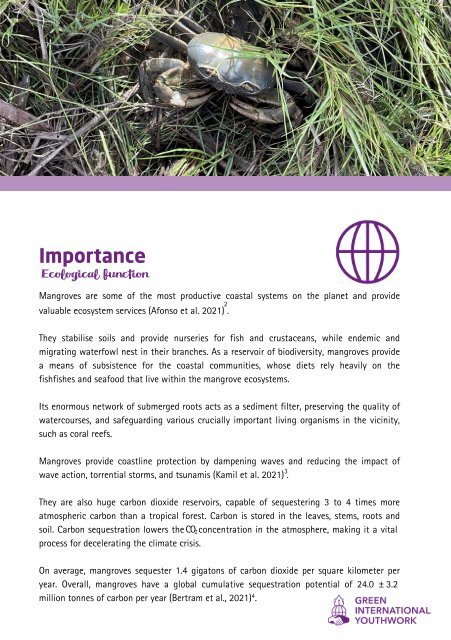Mangroves- natural heroes to combat climate change
You also want an ePaper? Increase the reach of your titles
YUMPU automatically turns print PDFs into web optimized ePapers that Google loves.
Importance<br />
Ecological function<br />
<strong>Mangroves</strong> are some of the most productive coastal systems on the planet and provide<br />
2<br />
valuable ecosystem services (Afonso et al. 2021) .<br />
They stabilise soils and provide nurseries for fish and crustaceans, while endemic and<br />
migrating waterfowl nest in their branches. As a reservoir of biodiversity, mangroves provide<br />
a means of subsistence for the coastal communities, whose diets rely heavily on the<br />
fishfishes and seafood that live within the mangrove ecosystems.<br />
Its enormous network of submerged roots acts as a sediment filter, preserving the quality of<br />
watercourses, and safeguarding various crucially important living organisms in the vicinity,<br />
such as coral reefs.<br />
<strong>Mangroves</strong> provide coastline protection by dampening waves and reducing the impact of<br />
wave action, <strong>to</strong>rrential s<strong>to</strong>rms, and tsunamis (Kamil et al. 2021) 3 .<br />
They are also huge carbon dioxide reservoirs, capable of sequestering 3 <strong>to</strong> 4 times more<br />
atmospheric carbon than a tropical forest. Carbon is s<strong>to</strong>red in the leaves, stems, roots and<br />
soil. Carbon sequestration lowers the C O 2 concentration in the atmosphere, making it a vital<br />
process for decelerating the <strong>climate</strong> crisis.<br />
On average, mangroves sequester 1.4 giga<strong>to</strong>ns of carbon dioxide per square kilometer per<br />
year. Overall, mangroves have a global cumulative sequestration potential of 24.0 ± 3.2<br />
million <strong>to</strong>nnes of carbon per year (Bertram et al., 2021) 4 .

















